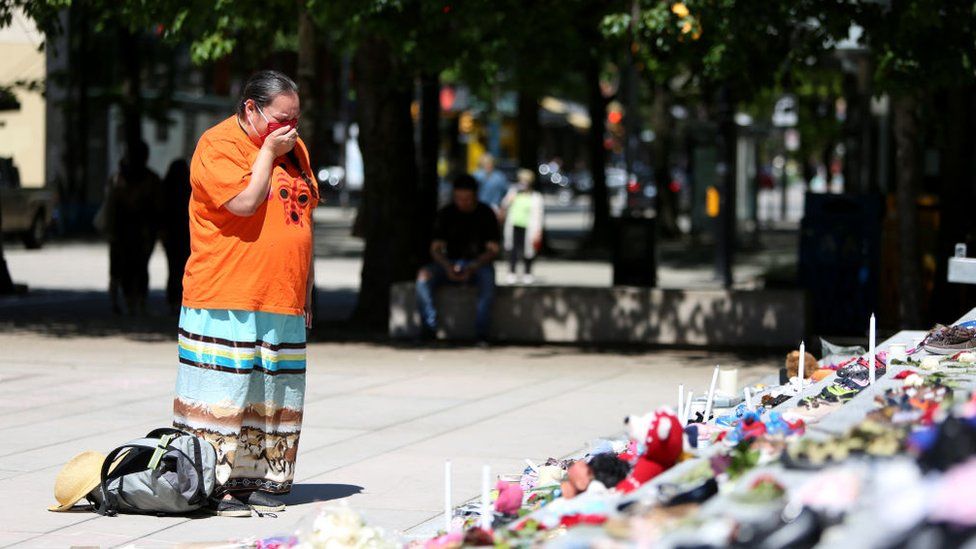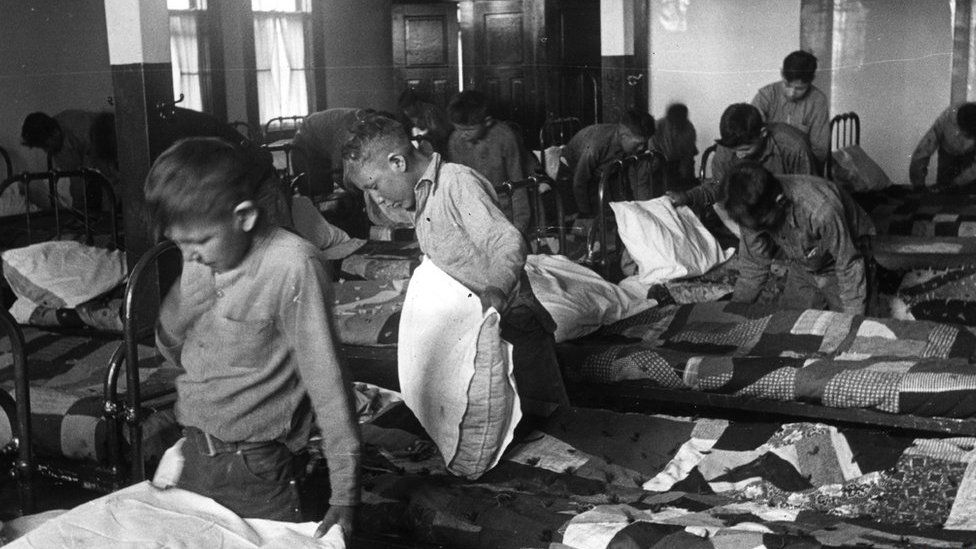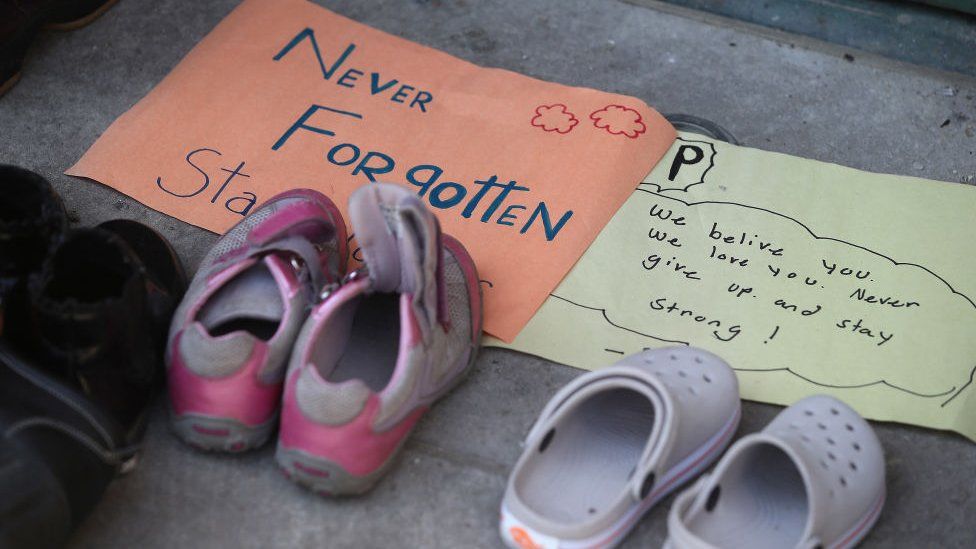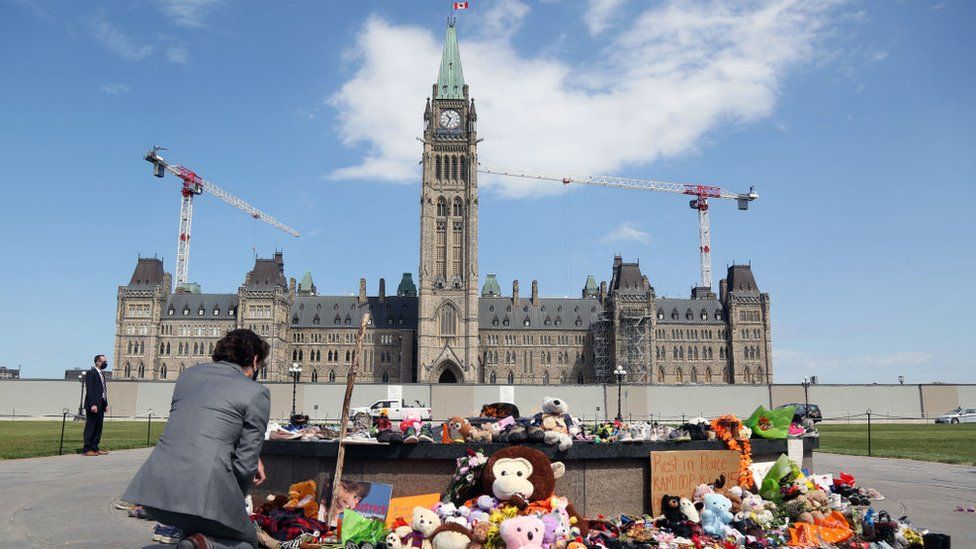
Link : The preliminary discovery in May of the remains of 215 Indigenous children – students of Canada’s largest residential school – has prompted nationwide outrage and calls for further searches of unmarked graves. This week, the Cowessess First Nation in Saskatchewan announced it had found 751 unmarked graves after a similar investigation. Here’s what we know so far.
The announcements have provided early previews of investigations by Canada’s First Nations into the deaths of residential school students.
These government-run boarding schools were part of policy to attempt to assimilate Indigenous children and destroy Indigenous cultures and languages.
What do we know about the preliminary findings?
In May, Tk’emlúps te Secwépemc Chief Rosanne Casimir announced that the remains of 215 children had been found near the city of Kamloops in southern British Columbia (BC).
Some of remains are believed to be of children as young as three.
All of the children had been students at the Kamloops Indian Residential School – the largest such institution in Canada’s residential school system.
The remains had been confirmed days before with the help of ground-penetrating radar technology, Chief Casimir said, following preliminary work on identifying the burial sites in the early 2000s.
The full report into the remains found is due in late June, and the preliminary findings may be revised. Indigenous leaders and advocates have said they expect the 215 figure to rise.
“Regrettably, we know that many more children are unaccounted for,” said Chief Casimir in a statement.
Thousands of children died in residential schools and their bodies rarely returned home. Many were buried in neglected graves.
In Saskatchewan, the 751 unmarked graves were found near the former Marieval Indian Residential School, which operated from 1899 in 1996 under the control of the Roman Catholic Church.
Cowessess leaders have not yet determined if all of the unmarked graves belonged to children. Technical teams will continue the investigation to provide verified numbers.
Chief Cadmus Delorme emphasised that the discovery was of unmarked graves – not a mass grave site – and suggested that the Catholic Church may have removed grave markers at some point in the 1960s.
To this day there is no full picture of the number of children who died in residential schools, the circumstances of their deaths, or where they are buried. Efforts like those of the Tk’emlúps te Secwépemc First Nation and the Cowessess First Nation are helping to piece some of that history together.
- Canada-wide search urged as children’s remains found
- Canada reveals names of 2,800 victims of residential schools
- Giving a voice to missing and murdered women
The Kamloops school, which operated between 1890 and 1969, held up to 500 Indigenous students at any one time, many sent to live at the school hundreds of kilometres from their families. Between 1969 and 1978, it was used as a residence for students attending local day schools.
Of the remains found, 50 children are believed to have already been identified, said Stephanie Scott, executive director of the National Centre for Truth and Reconciliation. Their deaths, where known, range from 1900 to 1971.
But for the other 165, there are no available records to mark their identities.
Children “ended up in pauper graves,” Ms Scott said. “Unmarked, unknown.”
The findings incited anger throughout Canada, with people creating makeshift memorials across the country.
But for Indigenous leaders, the discovery was not unexpected.
“The outrage and the surprise from the general public is welcome, no question,” said Assembly of First Nations National Chief Perry Bellegarde following the BC report. “But the report is not surprising.”
“Survivors have been saying this for years and years – but nobody believed them,” he said.
What are residential schools?
The Kamloops residential school was one of more than 130 others like it. The schools were operated in Canada between 1874 and 1996. https://emp.bbc.com/emp/SMPj/2.43.3/iframe.htmlmedia caption”No reconciliation without truth”: A survivor recounts abuse in Canadian residential school
A linchpin in the government’s policy of forced assimilation, some 150,000 First Nations, Métis and Inuit children were taken from their families during this period and placed in state-run boarding schools.
When attendance became mandatory in the 1920s, parents faced threat of prison if they failed to comply.
The policy traumatised generations of Indigenous children, who were forced to abandon their native languages, speak English or French and convert to Christianity.
Christian churches were essential in the founding and operation of the schools. The Roman Catholic Church in particular was responsible for operating up to 70% of residential schools, according to the Indian Residential School Survivors Society.
“It was our government’s policy to ‘get rid of the Indian’ in the child,” said Chief Bellegarde. “It was a breakdown of self, the breakdown of family, community and nation.”

The landmark Truth and Reconciliation Commission (TRC) report, released in 2015, described the government-led policy as cultural genocide.
The 4,000-page report detailed sweeping failures in the care and safety of these children, and complicity by the church and government.
“Government, church and school officials were well aware of these failures and their impact on student health,” the authors wrote. “If the question is, ‘who knew what when?’ the clear answer is: ‘Everyone in authority at any point in the system’s history.'”
Students were often housed in poorly built, poorly heated, and unsanitary facilities, the report said. Many lacked access to trained medical staff and were subject to harsh and often abusive punishment.
The squalid health conditions, the report said, were largely a function of the government’s resolve to cut costs.
“We have records in our archives of school administrations arguing with the Indian affairs government at the time about who was going to pay for the funerals of students,” Ms Scott said. “They would do it all at minimal expense.”
What do we know about the search for missing children across Canada?
Research by the TRC found that thousands of Indigenous children sent to residential schools never made it home.
Physical and sexual abuse led some to run away. Others died of disease or by accident amid neglect. As late as 1945, the death rate for children at residential schools was nearly five times higher than that of other Canadian schoolchildren. In the 1960s, the rate was still double that of the general student population.

“Survivors talked about children who suddenly went missing. Some talked about children who went missing into mass burial sites,” said TRC chair Murray Sinclair in a statement in May.
Other survivors spoke of infants fathered by priests at the school, taken from their mothers at birth and thrown into furnaces, he said.
In 2015, it was estimated some 6,000 children had died while at residential schools. So far, more than 4,100 children have been identified.
“We know there are lots of sites similar to Kamloops that are going to come to light in the future,” Mr Sinclair said. “We need to begin to prepare ourselves for that.”
What has been done?
In 2015, the TRC issued 94 calls to action, including six recommendations regarding missing children and burial grounds. Prime Minister Trudeau promised to “fully implement” all of them.
- According to a running count by the CBC, 10 of the projects have been completed, 64 are in progress and 20 have not begun
- The TRC, struck in 2009, fought for the issue of unmarked burial sites to be included in its mandate
- In 2019, the government committed C$33.8m ($28m; £19.8m) over three years to develop and maintain a school student death register and set up an online registry of residential school cemeteries
- So far, the National Centre for Truth and Reconciliation says it has received just a fraction of this money
What has been the reaction?
In June, Mr Trudeau said he was “appalled” by Canada’s legacy of residential schools and pledged “concrete action” – but provided few details.
“Trudeau has been willing to move on this, he’s got a lot of words, but we really need to see action,” Ms Scott said.
Ms Scott, along with Chief Bellegarde and other Indigenous leaders, have pressed the government for a thorough investigation of all 130 former school sites to find any unmarked graves.
These children have been “discarded”, Chief Bellegarde said. “That’s not acceptable.”

The preliminary findings have also renewed demands for an apology from the Catholic Church – one of the calls to action in the TRC report.
In 2017, Mr Trudeau asked Pope Francis to apologise for the church’s role in running Canada’s residential schools – but the church has so far declined.
The United, Anglican and Presbyterian churches issued formal apologies in the 1980s and 1990s.
An apology from the Catholic church would be “healing”, said Chief Bellegarde. “It’s part of closing that wound.”
News of the BC discovery spurred a global response, prompting statements from Human Rights Watch and the United Nations.